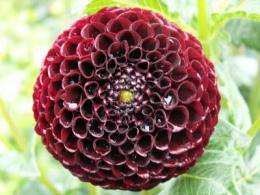Le Rouge et le Noir: Where the black dahlia gets its color

The molecular mechanisms whereby a spectrum of dahlias, from white to yellow to red to purple, get their colour are already well known, but the black dahlia has hitherto remained a mystery. Now, a study published in BioMed Central's open-access journal BMC Plant Biology reveals for the first time that the distinctive black-red colouring is based on an increased accumulation of anthocyanins as a result of drastically reduced concentrations of flavones.
Dahlia variabilis hort. is a popular garden flower. Continuous dahlia breeding worldwide has led to the availability of a huge number of cultivars – 20,000 varieties – many of them showing red hues. However, black hues of dahlia flowers occur rarely, in comparison.
Flower colour in dahlias is exclusively based on the accumulation of a group of metabolites called flavonoids, for example anthocyanins, flavones and flavonols. It's known that red tones arise from anthocyanins, whilst white and yellow tones lack anthocyanins but contain large amounts of flavones and chalcones respectively. Flavones and flavonoids are colourless, but they influence flower colouration by acting as co-pigments, interacting with anthocyanins to stabilize their structures. It is assumed that flavones rather than flavonols are the predominant co-pigments present in dahlias since all cultivars show high flavone synthase II (FNS) enzyme activity and low flavonol synthase activity.
To examine the biochemical basis for the distinctive dark colouring of the black dahlia, the research team from the Vienna University of Technology in Austria used pigment, enzyme and gene expression analyses. They determined that the majority of black cultivars have very low concentrations of flavones, as confirmed by low FNS II expression. Since flavones compete with anthocyanin biosynthesis for common intermediates, the lack of flavones favours the accumulation of huge amounts of anthocyanins that are found in black dahlias. The flavonol contents of black dahlias increased slightly parallel to the decrease of flavones.
Heidi Halbwirth, lead author, emphasised that the black colour of dahlias is not due to increased activity of the anthocyanin pathway, but rather is the result of the intermediates being converted into anthocyanins at the expense of formation of flavones.
Halbwirth commented, "The molecular explanation for the specific suppression of flavone formation in the majority of black dahlias will be of interest for further research. As the dahlia is an octoploid plant and the presence of several alleles is expected, the simultaneous suppression of all FNS II isoenzymes indicates an effective mechanism that could be used for engineering plants with tailor-made flavone contents."
More information: 'Le Rouge et le Noir': A decline in flavone formation correlates with the rare color of black dahlia (Dahlia variabilis hort.) flowers Jana Thill, Silvija Miosic, Romel Ahmed, Karin Schlangen, Gerlinde Muster, Karl Stich and Heidi Halbwirth, BMC Plant Biology (in press)
Journal information: BMC Plant Biology
Provided by BioMed Central
















